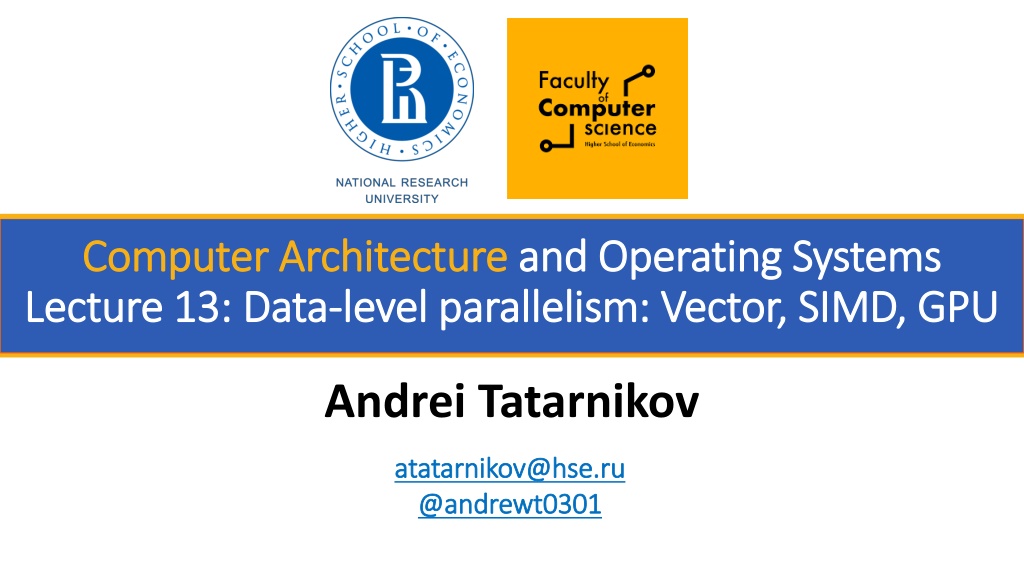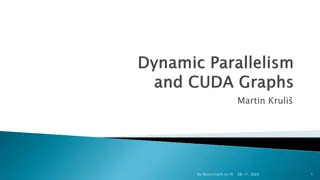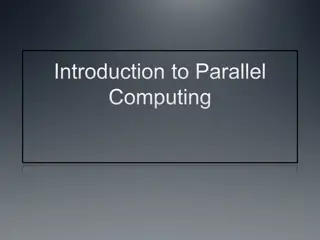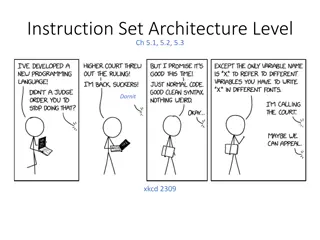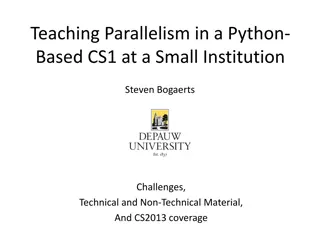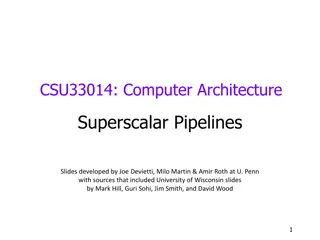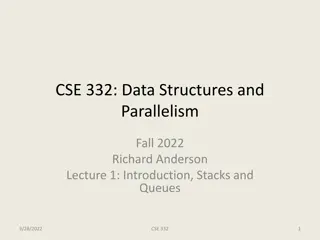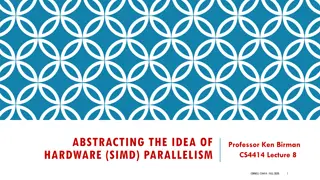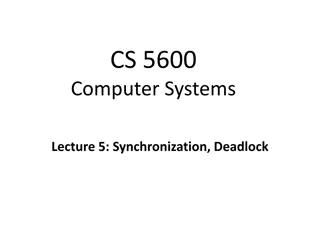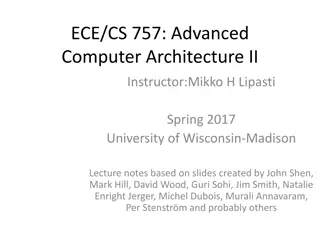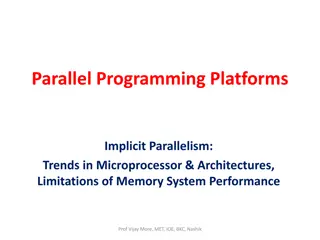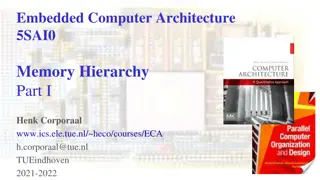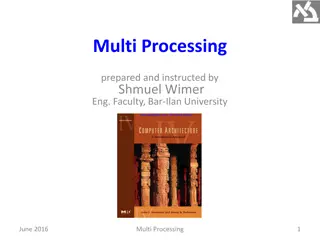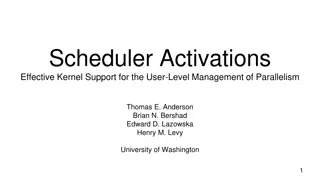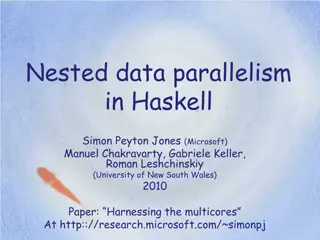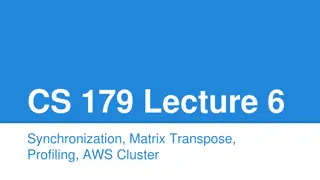Data-level Parallelism in Computer Architecture
This session delves into Data-level parallelism, focusing on Vector, SIMD, and GPU parallelism in computer architecture and operating systems. Topics covered include Instruction-level Parallelism (ILP), Multiple-Issue strategies, Speculation techniques, and Compiler/Hardware Speculation for optimizing performance.
Download Presentation

Please find below an Image/Link to download the presentation.
The content on the website is provided AS IS for your information and personal use only. It may not be sold, licensed, or shared on other websites without obtaining consent from the author. Download presentation by click this link. If you encounter any issues during the download, it is possible that the publisher has removed the file from their server.
E N D
Presentation Transcript
Computer Architecture Computer Architecture and Operating Systems Lecture Lecture 13 13: Data : Data- -level parallelism: Vector, SIMD, GPU level parallelism: Vector, SIMD, GPU and Operating Systems Andrei Tatarnikov atatarnikov@hse.ru atatarnikov@hse.ru @andrewt0301 @andrewt0301
Instruction Instruction- -Level Parallelism (ILP) Level Parallelism (ILP) Pipelining: executing multiple instructions in parallel To increase ILP Deeper pipeline Less work per stage shorter clock cycle Multiple issue Replicate pipeline stages multiple pipelines Start multiple instructions per clock cycle CPI < 1, so use Instructions Per Cycle (IPC) E.g., 4GHz 4-way multiple-issue 16 BIPS, peak CPI = 0.25, peak IPC = 4 But dependencies reduce this in practice 2
Multiple Issue Multiple Issue Static multiple issue Compiler groups instructions to be issued together Packages them into issue slots Compiler detects and avoids hazards Dynamic multiple issue CPU examines instruction stream and chooses instructions to issue each cycle Compiler can help by reordering instructions CPU resolves hazards using advanced techniques at runtime 3
Speculation Speculation Guess what to do with an instruction Start operation as soon as possible Check whether guess was right If so, complete the operation If not, roll-back and do the right thing Common to static and dynamic multiple issue Examples Speculate on branch outcome Roll back if path taken is different Speculate on load Roll back if location is updated 4
Compiler/Hardware Speculation Compiler/Hardware Speculation Compiler can reorder instructions e.g., move load before branch Can include fix-up instructions to recover from incorrect guess Hardware can look ahead for instructions to execute Buffer results until it determines they are actually needed Flush buffers on incorrect speculation 5
Static Multiple Issue Static Multiple Issue Compiler groups instructions into issue packets Group of instructions that can be issued on a single cycle Determined by pipeline resources required Think of an issue packet as a very long instruction Specifies multiple concurrent operations Very Long Instruction Word (VLIW) 6
Scheduling Static Multiple Issue Scheduling Static Multiple Issue Compiler must remove some/all hazards Reorder instructions into issue packets No dependencies with a packet Possibly some dependencies between packets Varies between ISAs; compiler must know! Pad with nop if necessary 7
RISC RISC- -V with Static Dual Issue V with Static Dual Issue Two-issue packets One ALU/branch instruction One load/store instruction 64-bit aligned ALU/branch, then load/store Pad an unused instruction with nop Address Instruction type Pipeline Stages n ALU/branch IF ID EX MEM WB n + 4 Load/store IF ID EX MEM WB n + 8 ALU/branch IF ID EX MEM WB n + 12 Load/store IF ID EX MEM WB n + 16 ALU/branch IF ID EX MEM WB 8 n + 20 Load/store IF ID EX MEM WB
Dynamic Multiple Issue Dynamic Multiple Issue Superscalar processors CPU decides whether to issue 0, 1, 2, each cycle Avoiding structural and data hazards Avoids the need for compiler scheduling Though it may still help Code semantics ensured by the CPU 9
Dynamic Pipeline Scheduling Dynamic Pipeline Scheduling Allow the CPU to execute instructions out of order to avoid stalls But commit result to registers in order Example ld x31,20(x21) add x1,x31,x2 sub x23,x23,x3 andi x5,x23,20 Can start sub while add is waiting for ld 10
Why Do Dynamic Scheduling? Why Do Dynamic Scheduling? Why not just let the compiler schedule code? Not all stalls are predicable e.g., cache misses Can t always schedule around branches Branch outcome is dynamically determined Different implementations of an ISA have different latencies and hazards 11
Dynamically Scheduled CPU Dynamically Scheduled CPU Preserves dependencies Hold pending operands Results also sent to any waiting reservation stations Reorders buffer for register writes Can supply operands for issued instructions 12
Does Multiple Issue Work? Does Multiple Issue Work? Yes, but not as much as we d like Programs have real dependencies that limit ILP Some dependencies are hard to eliminate e.g., pointer aliasing Some parallelism is hard to expose Limited window size during instruction issue Memory delays and limited bandwidth Hard to keep pipelines full Speculation can help if done well 13
Conclusion Conclusion ISA influences design of datapath and control Datapath and control influence design of ISA Pipelining improves instruction throughput using parallelism More instructions completed per second Latency for each instruction not reduced Hazards: structural, data, control Multiple issue and dynamic scheduling (ILP) Dependencies limit achievable parallelism Complexity leads to the power wall 14
Data Data- -Level Parallelism Level Parallelism Data-level parallelism is parallelism achieved by performing the same operation on independent data Best in dealing with arrays in for loops and processing other kinds of identically structured data Unsuitable for control flow structures 15
Instruction and Data Streams Instruction and Data Streams An alternate classification Data Streams Single Multiple Instruction Streams Single SISD: Intel Pentium 4 SIMD: SSE instructions of x86 Multiple MISD: No examples today MIMD: Intel Xeon e5345 SPMD: Single Program Multiple Data A parallel program on a MIMD computer Conditional code for different processors 16
Types of Parallel Processing Types of Parallel Processing Single instruction, single data (SISD) stream: A single processor executes a single instruction stream to operate on data stored in a single memory. Uniprocessors fall into this category. Single instruction, multiple data (SIMD) stream: A single machine instruction controls the simultaneous execution of a number of processing elements on a lockstep basis. Each has an associated data memory, so that instructions are executed on different sets of data by different processors. Vector and array processors fall into this category. Multiple instruction, single data (MISD) stream: A sequence of data is transmitted to a set of processors, each of which executes a different instruction sequence. Not commercially implemented. Multiple instruction, multiple data (MIMD) stream: A set of processors simultaneously execute different instruction sequences on different data sets. SMPs, clusters, and NUMA systems fit into this category. 17
Vector Processors Vector Processors Highly pipelined function units Stream data from/to vector registers to units Data collected from memory into registers Results stored from registers to memory Example: Vector extension to RISC-V v0 to v31: 32 64-element registers, (64-bit elements) Vector instructions fld.v, fsd.v: load/store vector fadd.d.v: add vectors of double fadd.d.vs: add scalar to each element of vector of double Significantly reduces instruction-fetch bandwidth 18
Example: DAXPY (Y = a Example: DAXPY (Y = a X + Y) X + Y) Conventional RISC-V code: f0,a(x3) # load scalar a x5,x19,512 # end of array X f1,0(x19) # load x[i] f1,f1,f0 # a * x[i] f2,0(x20) # load y[i] f2,f2,f1 # a * x[i] + y[i] f2,0(x20) # store y[i] x19,x19,8 # increment index to x x20,x20,8 # increment index to y x19,x5,loop # repeat if not done Vector RISC-V code: fld addi loop: fld fmul.d fld fadd.d fsd addi addi bltu fld fld.v fmul.d.vs v0,v0,f0 # vector-scalar multiply fld.v v1,0(x20) # load vector y fadd.d.v v1,v1,v0 # vector-vector add fsd.v v1,0(x20) # store vector y f0,a(x3) # load scalar a v0,0(x19) # load vector x 19
Vector vs. Scalar Vector vs. Scalar Vector architectures and compilers Simplify data-parallel programming Explicit statement of absence of loop-carried dependences Reduced checking in hardware Regular access patterns benefit from interleaved and burst memory Avoid control hazards by avoiding loops More general than ad-hoc media extensions (such as MMX, SSE) Better match with compiler technology 20
SIMD SIMD Operate elementwise on vectors of data E.g., MMX and SSE instructions in x86 Multiple data elements in 128-bit wide registers All processors execute the same instruction at the same time Each with different data address, etc. Simplifies synchronization Reduced instruction control hardware Works best for highly data-parallel applications 21
Vector vs. Multimedia Extensions Vector vs. Multimedia Extensions Vector instructions have a variable vector width, multimedia extensions have a fixed width Vector instructions support strided access, multimedia extensions do not Vector units can be combination of pipelined and arrayed functional units: 22
GPU Architectures GPU Architectures Processing is highly data-parallel GPUs are highly multithreaded Use thread switching to hide memory latency Less reliance on multi-level caches Graphics memory is wide and high-bandwidth Trend toward general purpose GPUs Heterogeneous CPU/GPU systems CPU for sequential code, GPU for parallel code Programming languages/APIs DirectX, OpenGL C for Graphics (Cg), High Level Shader Language (HLSL) Compute Unified Device Architecture (CUDA) 23
History of GPUs History of GPUs Early video cards Frame buffer memory with address generation for video output 3D graphics processing Originally high-end computers (e.g., SGI) Moore s Law lower cost, higher density 3D graphics cards for PCs and game consoles Graphics Processing Units Processors oriented to 3D graphics tasks Vertex/pixel processing, shading, texture mapping, rasterization 24
Example: NVIDIA Fermi Example: NVIDIA Fermi Multiple SIMD processors, each as shown: 25
Example: NVIDIA Fermi Example: NVIDIA Fermi SIMD Processor: 16 SIMD lanes SIMD instruction Operates on 32 element wide threads Dynamically scheduled on 16-wide processor over 2 cycles 32K x 32-bit registers spread across lanes 64 registers per thread context 26
GPU Memory Structures GPU Memory Structures 27
Concluding Remarks Concluding Remarks SIMD and vector operations match multimedia applications and are easy to program 28
Any Questions? Any Questions? 29
